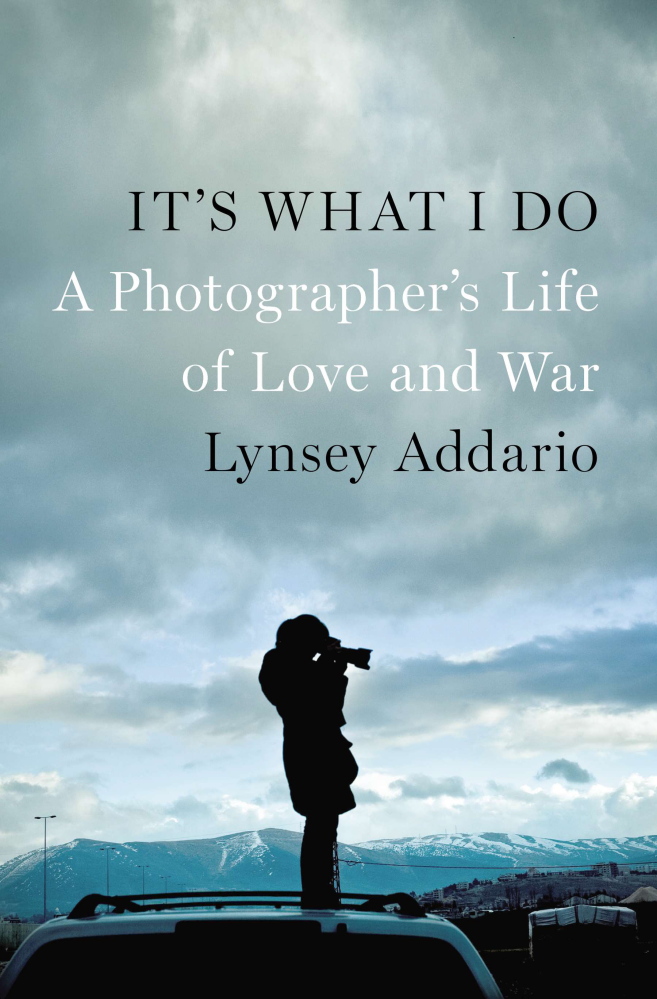It would be easy for “normal” people to conclude that journalists chronicling war and disaster are anything but.
Why would anyone in his or her right mind leave the comfort of middle-class America or Europe to document the savagery inflicted by Islamic terrorists on any Western hostage they can get their hands on? Or to witness the sadistic mutilation of rival factions’ women in places like the Democratic Republic of Congo?
Only someone a little crazy does that, the uninitiated might conclude. Or bent on basking in the glory of capturing an iconic image with wanton disregard for one’s own mortality. But such assumptions are a superficial and unfair reading of a journalist’s motivation to bring the reality of suffering, instability and injustice to the consciousness of those who might be moved to try to right the world’s wrongs.
In Lynsey Addario’s memoir, “It’s What I Do: A Photographer’s Life of Love and War,” precociously undertaken before she turned 40, she endeavors to explain the “why?”
She takes the reader through a decade of violence in Afghanistan and Iraq after Sept. 11, 2001, then on to the Arab Spring. As if to set the record straight on the death-wish allegation, Addario opens her story with a harrowing account of being trapped between the rebels and Moammar Gadhafi’s gunmen in the chaotic months before the Libyan leader was captured and executed.
“I hadn’t covered Tunisia and Egypt, because I was on assignment in Afghanistan, and it had pained me to miss such important moments in history. I wasn’t going to miss Libya,” Addario writes of one of the most powerful drivers that compel journalists to downgrade potential danger.
She and three other veteran conflict journalists were taken captive by Gadhafi’s gunmen, who bound and blindfolded them for an hours-long ride in the back of a pickup during which the men were punched and rifle-butted and Addario was fondled. The Libyan experience conveys effectively the judgment lapses and regrets that consume journalists when they ignore the ever-present subconscious hazard detector.
Failure to heed those warnings is an occupational hazard, especially for female journalists traveling with male colleagues. Addario expresses throughout the memoir her aversion to being seen as “the girl,” more easily scared and inclined to leave the scene.
“The fact is that trauma and risk taking hadn’t become scarier over the years; it had become more normal,” she writes of her oscillating regret and resignation during the detention at a Libyan prison and guesthouse.
Addario seldom waxes remorseful in her richly illustrated memoir, except when acknowledging the emotional trauma imposed on those who care about her.
Then there are the professional disappointments that inevitably afflict writers and photographers seeking to present a truthful image that military public affairs officers feel duty-bound to suppress. Addario’s devastating moment came after a grueling two-month embed with U.S. forces in Afghanistan’s Korengal Valley. A disturbing image she had taken of a young boy injured in a U.S. bombing raid was left out of the published photo essay for The New York Times Magazine because “the editor trusted the U.S. military public affairs officer – whose main responsibility was to polish the image of the U.S. military to the greater public – over us,” Addario recalls years later.
She also recounts the deaths of colleagues that have saddened and shocked her, including The New York Times’ Anthony Shadid, who was with her when she was taken hostage in Libya. He died in 2012 from an acute asthma attack while making his way out of Syria.
Addario’s memoir is replete with the downsides of witnessing war and chronicling its myriad tragedies, all of which leaves the reader struggling with “why?” Her answers are vague, as reflected in the memoir’s title. There is little historical context in the memoir, and Addario herself seems mystified by what she sees at times.
The book, though, doesn’t aspire to make sense of our violence-wracked world. It is narrowly focused on explaining photojournalism and the psychic rewards of influencing policymakers. She conveys well her unstated mission to stir the emotions of people like herself, born into relative security and prosperity, nudging them out of their comfort zones with visual evidence of horrors they might do something about.
It is a diary of an empathetic young woman who makes understanding the wider world around her a professional calling. By the end of her memoir, Addario slows ever so briefly to have a child with the man she marries after a minutely detailed decade of relationship misfires. Still, she returns to the scenes of chaos and violence, burdened anew with fears that her young son will grow up motherless.
“As a war correspondent and a mother, I’ve learned to live in two different realities … but it’s my choice,” she concludes. “I choose to live in peace and witness war – to experience the worst in people but to remember the beauty.”
It’s what she does.
Carol J. Williams has been a foreign correspondent since 1984.
Send questions/comments to the editors.



Success. Please wait for the page to reload. If the page does not reload within 5 seconds, please refresh the page.
Enter your email and password to access comments.
Hi, to comment on stories you must . This profile is in addition to your subscription and website login.
Already have a commenting profile? .
Invalid username/password.
Please check your email to confirm and complete your registration.
Only subscribers are eligible to post comments. Please subscribe or login first for digital access. Here’s why.
Use the form below to reset your password. When you've submitted your account email, we will send an email with a reset code.